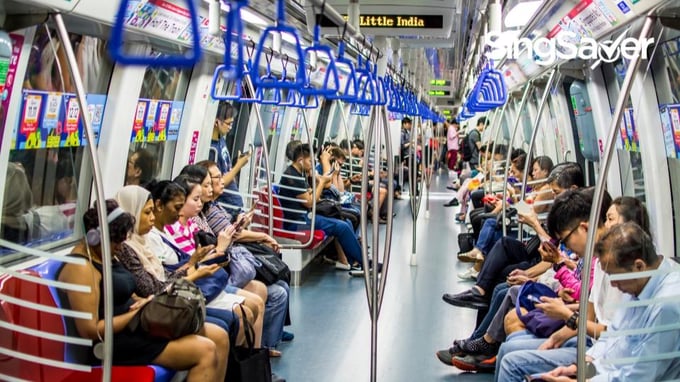Just as you were looking to embrace the new year with changes to your financial plans and saving habits, your cost of living quietly crept up.
Besides the new GST changes for digital services like Netflix, Spotify and Office 365, the cost of your daily commute also saw a recent hike. To be precise, a new public transport fare structure was introduced, starting December 28, 2019.
Changes to public transport fare for every Singaporean commuter
The only (and the biggest) beneficiary of this change are polytechnic students. That’s because polytechnic students previously did not enjoy any concession rate and had to pay adult fares for transport. Under the new fare structure, they now enjoy concession rates as students.
Apart from this section of commuters, every other commuter saw their card fares increase by $0.04/$0.09 per trip. Working (and non-working) adults saw the biggest increase in public transport fare with an increase by about $0.09 per trip.
In addition, prices for senior citizens, students of all ages, NSFs and adults who choose to pay their fare in cash have increased by 20 cents.
Here’s a summary of how the public transport fare has changed for every Singaporean commuter since the new public transport fare came into effect.
Regular commuter card fares
| Commuter group | Fare before 2020 | Fare from 2020 | Changes |
| Primary, secondary and junior college students | $0.59 | $0.63 | +$0.04 |
| Polytechnic students | $1.39 | $0.63 | -$0.76 (Poly students were paying adult fares. From 2020 onwards,they fall under the students category) |
| Low wage workers | $1.10 | $1.14 | +$0.04 |
| People with Disabilities | $0.88 | $0.92 | +$0.04 |
| Adults and full-time NSFs | $1.39 | $1.48 | +$0.09 |
| Senior citizen | $0.88 | $0.92 | +$0.04 |
Source: Straits Times
Concession passes
| Commuter group | Bus | Changes for bus | Train | Changes for train | Bus + train | Changes for bus + train |
| Primary student | $24.00 | + $2 | $21.00 | + $1 | $43.50 | + $2.50 |
| Secondary student | $29.00 | + $1.50 | $26.50 | + $1.50 | $54.00 | + $3 |
| Polytechnic student | $29.00 | + $1.50 | $26.50 | + $1.50 | $54.00 | + $3 |
| University student | $55.50 | + $3.50 | $48.00 | + $3 | $90.50 | +$5.50 |
| Full-time NSF | $55.50 | + $3.50 | $48.00 | + $3 | $90.50 | +$5.50 |
| Senior citizen and persons with disabilities | - | - | - | - | $64.00 | +$4 |
| Adult | - | - | - | - | $128.00 | +$8 |
Source: Land Transport Guru
Tips to save on your daily commute
With the increase in the cost of public transport, it is only normal that you’d want in on tips to unlock savings from your daily commute. We got this covered.
1. Take advantage of the pre-peak rail fares
If you take the MRT to work regularly, one way to cut your cost is to get to work earlier. To encourage commuters to start their rail journey earlier, MRT fares are discounted if you start before 7.45am on weekdays.
This is known as the pre-peak rail fares, which can be quite significant. Not to mention, you stand to make a pretty good impression at work (in case your company values early risers).
Case Study 1: Train journey only (16.6km)
| Commuter group | Current fare | Pre-peak rail fare |
| Adult | $1.61 | $1.11 |
| Senior citizen | $0.87 | $0.37 |
| Student | $0.58 | $0.08 |
Case Study 2: Train + bus journey (2.2km by bus + 2.6km by train)
| Commuter group | Current fare | Pre-peak rail fare |
| Adult | $0.77 + $0.20 = $0.97 | $0.77 + $0 = $0.77 |
| Senior citizen | $0.54 + $0.14 = $0.68 | $0.54 + $0 = $0.54 |
| Student | $0.37 + $0.10 = $0.47 | $0.37 + $0 = $0.37 |
2. Buy a monthly concession pass
For commuters who travel frequently, you will be most affected by the new public transport fare structure. Do a quick math and check if it makes sense for you to get a monthly travel pass. You might be able to get a few dollars of savings with the monthly travel pass under the new fare structure.
3. Get discounted fares with a cashback credit card
With the introduction of SimplyGo, you no longer have to use your EZlink card to tap for entry. MasterCard and Visa cards can also be used for your daily commute. This means that you can use your cashback credit card to pay for your public transport and earn some cashback.
For instance, DBS Live Fresh card lets you earn 5% cashback on your bus and train rides. Alternatively, you can also get a credit card that specialises in transport rebates such as the Citi SMRT card or Standard Chartered Unlimited Cashback Card.
Find the best cashback credit card using SingSaver’s credit card comparison tool here.
4. Earn rewards on your daily commute spend with credit card
The increase in the public transport fare can be a boon if you know how to take advantage of it. Have a rewards credit card? Guess what? You can use it to pay your fare and earn some well-deserved rewards off of it. In other words, you can turn your daily commute into miles by simply tapping with your credit card instead of an EZlink card.
Read these next:
6 Credit Cards You Should Use as Your EZ-Link Card
Which Online Grocery in Singapore Delivers the Biggest Savings?
Cashback or Rewards Credit Cards: Which is Better?
6 Credit Cards That Give Free Access To Airport Lounges
Amex, Mastercard or Visa: Which is Better for Travel?
Similar articles
What Do You Enjoy As A 60-Year-Old Senior Citizen In Singapore?
How To Earn Miles On MRT And Bus Rides With SimplyGo
15 Ways Life Is Financially Different Today For Singaporean Millennials Than Previous Generations: 1990s VS 2020s
4 Student Credit Cards That Also Earn You Miles and Cashback
The Real Cost: How Much Do I Need to Earn to Live Comfortably in Singapore?
Bus, MRT fares to cost 4 to 20 cents more per trip from Dec 28
The Real Cost: Ex-Busker-Turned-Actor Gavin Teo Says That He Earned A “Pretty Decent Amount” As A Street Singer, So Why Did He Quit?
UK Travel Guide (2023): Places To Visit, Cost & More










